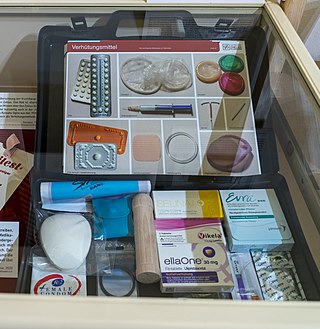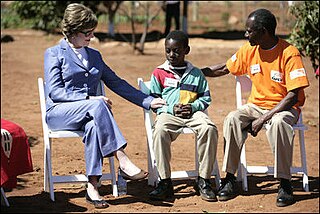Related Research Articles

Sex education, also known as sexual education, sexualityeducation or sex ed, is the instruction of issues relating to human sexuality, including human sexual anatomy, sexual activity, sexual reproduction, safe sex and birth control, sexual health, reproductive health, emotional relations and responsibilities, age of consent, and reproductive rights. Sex education that includes all of these issues is known as comprehensive sex education, and is often opposed to abstinence-only sex education, which only focuses on sexual abstinence. Sex education may be provided as part of school programs, public health campaigns, or by parents or caregivers. In some countries it is known as "Relationships and Sexual Health Education".

Teenage pregnancy, also known as adolescent pregnancy, is pregnancy in a female adolescent or young adult under the age of 20. Worldwide, pregnancy complications are the leading cause of death for women and girls 15 to 19 years old. The definition of teenage pregnancy includes those who are legally considered adults in their country. The WHO defines adolescence as the period between the ages of 10 and 19 years. Pregnancy can occur with sexual intercourse after the start of ovulation, which can happen before the first menstrual period (menarche). In healthy, well-nourished girls, the first period usually takes place between the ages of 12 and 13.

Family planning is the consideration of the number of children a person wishes to have, including the choice to have no children, and the age at which they wish to have them. Things that may play a role on family planning decisions include marital situation, career or work considerations, financial situations. If sexually active, family planning may involve the use of contraception and other techniques to control the timing of reproduction.
Reproductive rights are legal rights and freedoms relating to reproduction and reproductive health that vary amongst countries around the world. The World Health Organization defines reproductive rights as follows:
Reproductive rights rest on the recognition of the basic right of all couples and individuals to decide freely and responsibly the number, spacing and timing of their children and to have the information and means to do so, and the right to attain the highest standard of sexual and reproductive health. They also include the right of all to make decisions concerning reproduction free of discrimination, coercion and violence.
The Sexuality Information and Education Council of the United States, or simply SIECUS, is a national, nonprofit organization based in Washington, D.C., dedicated to advancing sex education through advocacy, policy, and coalition building. SIECUS develops, collects, and disseminates information, promotes comprehensive education about sexuality, and advocates the right of individuals to make responsible sexual choices. It is widely regarded as the institutional voice of these concerns and a pioneer of the comprehensive sex education program.

Sexual and reproductive health (SRH) is a field of research, health care, and social activism that explores the health of an individual's reproductive system and sexual well-being during all stages of their life.

Mary Steichen Calderone was an American physician, author, public speaker, and public health advocate for reproductive rights and sex education. Known as the "mother of sex education" as well as the "grande dame of sex education", Calderone played a significant role in the promotion in the advancement of reproductive rights and sex education in the United States. Her notable achievements included her involvement in efforts to reevaluate and reform abortion laws in the U.S., pushing for the integration of birth control into mainstream medical practices, and transforming sex education from a vague, morally focused approach to a scientifically informed and comprehensive framework.

Abstinence-only sex education is a form of sex education that teaches not having sex outside of marriage. It often excludes other types of sexual and reproductive health education, such as birth control and safe sex. Comprehensive sex education, by contrast, covers the use of birth control and sexual abstinence.
Comprehensive sexuality education (CSE) is a sex education instruction method based on a curriculum that aims to give students the knowledge, attitudes, skills, and values to make appropriate and healthy choices in their sexual lives. The intention is that this understanding will help prevent students from contracting sexually transmitted infections (STIs) such as HIV and HPV, reduce unplanned and unwanted pregnancies, as well as lowering rates of domestic and sexual violence.
Abstinence, be faithful, use a condom, also known as the ABC strategy or abstinence-plus sex education, also known as abstinence-based sex education, is a sex education policy based on a combination of "risk avoidance" and harm reduction which modifies the approach of abstinence-only sex education by including education about the value of partner reduction safe sex and birth control methods. Abstinence-only sex education is strictly to promote the sexual abstinence until marriage, and does not teach about safe sex or contraceptives. The abstinence-based sex education program is meant to stress abstinence and include information on safe sex practices. In general terms, this strategy of sex education is a compromise between abstinence-only education and comprehensive sex education. The ABC approach was developed in response to the growing epidemic of HIV/AIDS in Africa, and to prevent the spread of other sexually transmitted diseases. This approach has been credited by some with the falling numbers of those infected with AIDS in Uganda, Kenya and Zimbabwe, among others. From 1990 to 2001 the percentage of Ugandans living with AIDS fell from 15% to between 5 and 6%. This fall is believed to result from the employment of the ABC approach, especially reduction in the number of sex partners, called "Zero-Grazing" in Uganda.
The sexuality of US adolescents includes their feelings, behaviors and development, and the place adolescent sexuality has in American society, including the response of the government, educators, parents, and other interested groups.
Contraceptive security is an individual's ability to reliably choose, obtain, and use quality contraceptives for family planning and the prevention of sexually transmitted diseases. The term refers primarily to efforts undertaken in low and middle-income countries to ensure contraceptive availability as an integral part of family planning programs. Even though there is a consistent increase in the use of contraceptives in low, middle, and high-income countries, the actual contraceptive use varies in different regions of the world. The World Health Organization recognizes the importance of contraception and describes all choices regarding family planning as human rights. Subsidized products, particularly condoms and oral contraceptives, may be provided to increase accessibility for low-income people. Measures taken to provide contraceptive security may include strengthening contraceptive supply chains, forming contraceptive security committees, product quality assurance, promoting supportive policy environments, and examining financing options.
Advocates for Youth is a nonprofit organization and advocacy group based in Washington, D.C., United States, dedicated to sexuality education, the prevention of HIV and of sexually transmitted disease, teenage pregnancy prevention, youth access to condoms and contraception, equality for LGBT youth, and youth participation. In addition, Advocates for Youth sponsors media campaigns and other forms of outreach which attempt to change societal norms to be more understanding of, accepting, of, and responsible about youth sexuality and to drive youth sexual health equity.

Birth control, also known as contraception, anticonception, and fertility control, is the use of methods or devices to prevent unintended pregnancy. Birth control has been used since ancient times, but effective and safe methods of birth control only became available in the 20th century. Planning, making available, and using human birth control is called family planning. Some cultures limit or discourage access to birth control because they consider it to be morally, religiously, or politically undesirable.
In the United States, sex education is taught in two main forms: comprehensive sex education and abstinence-only as part of the Adolescent Family Life Act, or AFLA. Comprehensive sex education is also called abstinence-based, abstinence-plus, abstinence-plus-risk-reduction, and sexual risk reduction sex education. This approach covers abstinence as a choice option, but also informs adolescents about age of consent and the availability of contraception and techniques to avoid contraction of sexually transmitted infections. Every state within the U.S. has a mandated AIDS Education Program.
Sexuality in the Philippines encompasses sexual behavior, sexual practices, and sexual activities exhibited by men and women of the Philippines past and the present. It covers courtship strategies for attracting partners for physical and emotional intimacy, sexual contact, sexual reproduction, building a family, and other forms of individual interactions or interpersonal relationships, as set and dictated by their culture and tradition, religion, beliefs, values and moral convictions, psychology, foreign influences, and other related factors.
True Relationships & Reproductive Health, or more commonly known as True, is a non-profit organisation that promotes sexual and reproductive health to Queensland, a state in Australia. It was established in 1972, and runs nine regional centres across Queensland.

Latin America is home to some of the few countries of the world with a complete ban on abortion and minimal policies on reproductive rights, but it also contains some of the most progressive reproductive rights movements in the world.
Sex education is a very controversial and taboo subject in India, and people's opinions about it are quite divided. The states of Gujarat, Maharashtra, Madhya Pradesh and Chhattisgarh have banned or refused to implement sex education in school to preserve culture. The Hindu nationalist government in Madhya Pradesh said sex education had “no place in Indian culture” and plans to introduce yoga in schools instead. For history regarding family planning in India, see Family Planning in India.

Sóley Sesselja Bender is a professor at the Faculty of Nursing of the University of Iceland. Her specialty is sexual and reproductive health, where she has worked for years on these health matters. She has pioneered in the development of teaching in the field of sexual and reproductive health, contraceptive counselling, and sexual and reproductive health policy formulation in Iceland and internationally.
References
- ↑ "Emotional Relationships: Types, Challenges and Physical/Mental Health Impacts – Nova Science Publishers" . Retrieved 2023-01-16.
- 1 2 Loeber, O.; Reuter, S.; Apter, van der Doef; Lazdane, Pinter (June 2010). "Aspects of sexuality education in Europe – definitions, differences, and developments". European Journal of Contraception & Reproductive Health Care. 15 (3): 169–176. doi:10.3109/13625181003797280. PMID 20465399.
- 1 2 3 4 5 6 7 8 9 10 11 12 13 14 15 16 17 SAFE 2006.
- ↑ Macdowall; Wellings, Mercer; Nanchahal, Copas; McManus, Fenton; Erens, Johnson (2000). "Learning about sex: Results from Natsal". Journal of Health Education and Behaviour.
- ↑ SAFE 2006, pp. 24–25.
- 1 2 3 4 5 6 SAFE 2006, pp. 26–28.
- ↑ "A lifecourse approach to sexual and reproductive health. Entre Nous No.82, 2015". www.euro.who.int. Retrieved 2021-12-15.
- ↑ Policies for sexuality education in the European Union : note. Karolina Beaumont, Marcia Maguire, European Parliament. Directorate-General for Internal Policies. Policy Department C: Citizens' Rights and Constitutional Affairs. Luxembourg: EUR-OP. 2013. ISBN 978-92-823-4253-4. OCLC 953823609.
{{cite book}}: CS1 maint: others (link) - ↑ SAFE 2006, pp. 46–47.
- ↑ SAFE 2006, pp. 48–50.
- ↑ SAFE 2006, pp. 53–55.
- ↑ SAFE 2006, pp. 56–57.
- ↑ SAFE 2006, pp. 58–59.
- ↑ SAFE 2006, pp. 60–61.
- ↑ SAFE 2006, pp. 62–63.
- ↑ SAFE 2006, pp. 67–68.
- ↑ SAFE 2006, pp. 75–76.
- ↑ McLean, Shauna (2013). "Ideology and Inequality in Canadian Sex Education Films".